By Samantha Bey
Only two decades ago, the Barrio Logan neighborhood, just on the east side of the Coronado Bridge, wasn’t quite the bustling enclave of art galleries, music and food that it’s become today.
Since the early 1970s, vibrant murals have adorned the bridge’s pillars in Chicano Park (now a National Historic Landmark), telling a story of activism and triumph and paying homage to the neighborhood’s rich Hispanic heritage. But the streets surrounding those colorful pillars are, as of recent years, bursting with new life, and the neighborhood is now a destination for its notable gallery scene and authentic eateries. Still, even with this influx, the neighborhood is staunchly committed to staying true to its roots of culture and public art.
Bread & Salt is one collective art space that captures the creative, community-centered vibe of the Barrio. Located in an enormous warehouse that operated as a bread factory from 1896 to 2006, the space occupies half a city block and is separated into large, open exhibit spaces, where local artists showcase a dynamic array of works. Thomas DeMello, the gallery’s curator and manager, explained that the gallery’s name was partially derived from its building’s history, but the word “salt” was added as a subtle allusion to decent, “salt of the earth” people. “We would never charge for an art exhibit,” said DeMello. “The vision here was being a community-based arts building accessible to the public.” The gallery hosts a number of art lectures, exhibits, and community events, all of which are free.
Harry Holiday is an illustrator who rents space in the building and chose Barrio Logan because of its “underground surge of artistic energy.” David Reynoso, who hails from Guadalajara, Mexico, began renting a space within Bread & Salt in July to put on his production of “Waking La Llorena,” an interactive play based on popular Mexican folklore where only one audience member is allowed in at a time to experience different vignettes that tell the tale. “It’s very affordable to be here,” he said, referencing the low fee he pays to be part of the cooperative. “I feel lucky to be able to bring my work to the community and to be in the company of such vibrant artists.”
Brett Stampf and John Bull opened Alta Brewery within the bread warehouse in August. “We’re part of an art space, and the truth is that making good beer is an art in itself,” said Stampf. The duo hired Mexicali artist Gloria Muriel to paint a wall-size mural of a horned bull (their mascot), and chose the name “Alta” because it means “above and beyond” in Spanish. Both choices show the dedication to stay true to the roots of their new neighborhood. “So many breweries in San Diego now operate out of industrial parks. But we get to be in the middle of so much art and culture. That’s cool,” said Bull.
Though eyes began turning to the Barrio a few years ago, it seems to have hit a critical mass as of late. “We really started seeing a boom of new business about two years ago in 2015,” said Chris Zertuche, who owns the popular La Bodega Gallery on Logan Avenue, which opened in October 2013. “But now I see new businesses open every month, from art supply stores to tamale shops to vintage clothing to hair salons. Logan Avenue has become a really exciting place,” he said.
Zertuche’s gallery inhabits a warehouse built in 1917; the building was a Bank of Italy during the 1920s (the vault is still part of the gallery). Today, it’s an open space where anywhere from 40 to 100 local and international artists display their work. The gallery hosts rotating shows every weekend, featuring all different mediums, and open mic nights for poetry readings.
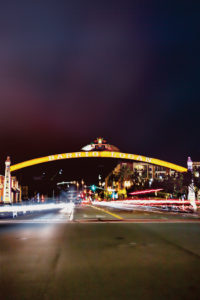
“La Bodega captures the spirit of the neighborhood,” Zertuche said. “We’re sticking to our roots in that we celebrate art and culture in a welcoming way. We’re free, any age is welcome (dogs, too!), and we have an accessible platform for artists to share their work.”
Don Woodard opened his company, Ol’ Fashioned Lumber, last summer in a warehouse space that was a military storage facility in the 1940s. He crafts custom furniture from reclaimed wood, using pieces from fallen trees from Washington, Oregon and California, old barn wood, and old marine wood — the latter of which has taken on subtle but gorgeous hues of rich turquoise. His workshop — lined wall to wall with enormous slabs of one-of-a-kind wood — serves as a sort of art gallery in itself. The upstairs corners of the warehouse space are occupied by two more companies: Specs Wax, which makes sunglasses out of old vinyl records, and Knotty Woods, which specializes in custom beer taps for popular restaurants and breweries all over San Diego. “A lot of the area is still zoned for industrial use,” explained Woodard, “and rent is still (semi) affordable, so it’s really appealing for business owners like us. Plus, there is an art to the work we do, and with so many cool new artists in town this just felt like the right fit.”
The neighborhood scene is an eclectic blend of newcomers and home-growns. Cesar Castaneda, who grew up in Barrio Logan, opened Chicano Art Gallery in December 2013. Even as the Barrio goes through such rapid change, this colorful space, just down the street from Chicano Park on Logan Avenue, is keeping its heritage alive by highlighting Chicano and Latino culture through art. Milo Lorenzana is a 16-year resident of Barrio Logan who opened the Por Vida Café & Galeria in November 2015. The café serves organic, fair trade coffee with a Mexican twist, such as the horchata latte, among traditional Mexican art and crafts, handmade in Mexico and by local artists. Of the booming influx of new galleries to the Barrio scene, Lorenzana said, “At the end of the day we’re all the same. We all have the same vision, and they all play a big part in the neighborhood: more local art and more opportunities for artists to express themselves. Even with all the new openings, Barrio still has its own distinct flavor of art — and it’s a place where everyone is welcome.” Lorenzano feels that the blend of the new and the established is part of the area’s renaissance. “There’s a lot of new blood, a lot of younger people here. But the elders are still here, still talking and painting and inspiring. And I think we’re getting a lot more attention because we’re community-focused, homegrown and so small, but the art here is making such a big impact. It’s always been here, but now we’ve brought a new flavor to it. It’s special, there’s nothing else like it.”
Lorenzana is a member of the Logan Avenue Consortium, which is dedicated to promoting businesses and events along its namesake street. The consortium runs the Barrio Art Crawl, which takes place the second Saturday of every month. Galleries, restaurants and businesses host special exhibits and events throughout the day for those eager to explore the burgeoning arts scene. The event demonstrates just how cool this enclave has become — art enthusiasts of all ages meander along the streets and hop in and out of brightly lit and inviting storefronts; art galleries are filled to capacity. The energy and buzz are undeniable.
With so much to explore in the Barrio, sustenance is a must. Ryan Brothers Coffee has been a neighborhood staple since it opened on Main Street in 2003. The family-run business took a chance on the area back then; the warm, brick interior of their bustling café and roastery remains a mecca for caffeine lovers. Newer to the block is Café Moto. The roasters provide sustainably farmed coffees and teas to establishments all over San Diego. Their café on National Avenue, also tucked inside an old warehouse, is decorated with reclaimed wood walls and contemporary motorcycle art and serves up delicious coffee specialties.
For a different type of buzz, try the Mexican craft beers at Border X Brewing on Logan Avenue. Their Horchata Golden Stout is brewed with whole cinnamon sticks and vanilla bean, and their Blood Saison is inspired by the traditional Mexican drink jamaica and made with real hibiscus and agave. The Iron Fist tasting room on National Avenue within the new Mercado del Barrio apartment and retail complex, serves up locally crafted beers either inside its minimalist walls or on its breezy outdoor patio, just steps from the Chicano Park skate park underneath the east pillars of the Coronado Bridge. The Mercado’s newest tenant is Attitude Brewery, occupying a 5,000-square-foot space in the northwest corner of the building. Owner Kurt Bach plans to hire locals and commission local artists to root his new project in the community.
Also within the Mercado del Barrio complex is the popular Mexican seafood restaurant Mariscos el Pulpo. Decorated floor to ceiling with nautical décor, Mariscos offers an array of casual seafood specialties, great fish tacos, and a full bar of tequila and mescal cocktails that you can enjoy on the open air patio or while catching a game on one of the bar’s many flat screen TVs.
Just across the complex is the bustling Northgate Market, a large grocery story packed with everyday needs and specializing in authentic Mexican foods. A variety of counters stock marinated meats, fresh-made tortillas, agua frescas, salsas, ceviches, house chips and more.
Nestled among all the new is a thriving classic: Las Cuatro Milpas. A Barrio Logan staple since 1935, its walk-up window still draws a regular crowd of San Diegans who swear their tacos are the best in Southern California. Their menu is very limited — think tacos, taquitos, rice and beans — but that doesn’t stop the crowds from lining up and often snaking around the block.
As more San Diegans catch a drift of the things happening in Barrio Logan, one thing is certain: rising housing prices. Joel Blumenfeld, a real estate agent with Berkshire Hathaway who has sold multiple homes in the Barrio, said he’s seeing a big influx of young professionals who’ve been priced out of areas like North Park and Downtown, but still want an urban lifestyle. As the demand for housing in the Barrio increases, so do home prices. But, said Blumenfeld, “you can still get a lot of bang for your buck there.” He explained that home prices have increased significantly – in the double digit percentages – in the past five years and that he expects they’ll keep rising. One concern? “With a whole new demographic coming in, there’s a lot of gentrification. Old buildings get torn down for new construction and hipster bars replace some of the culture that’s been there for decades.” Still, the neighborhood seems to be so enmeshed in and dedicated to its heritage that it won’t be easily lost. It’s a fight, in fact, that’s been fought — and won — before.
The area became a predominantly residential, Hispanic neighborhood when refugees from the Mexican Revolution flooded into Logan Heights in the early 20th century. In the 1960s the neighborhood took quite a beating with the additions of Interstate 5 and the Highway 75 on-ramp to the Coronado Bridge. More than 5,000 homes were torn down for the bridge’s construction. Disgruntled residents became further angered when they learned the city planned to erect a Highway Patrol facility under the new pillars. Salvador Torres, who lost his childhood home to the construction, along with many other activists staged a 12-day, nonviolent sit-in. Forming human chains to obstruct construction and camping out for two weeks while carrying out negotiations finally resulted in approval for a park, now Chicano Park. Torres had the vision to cover the pillars — then riddled with graffiti — with bright murals celebrating the Latino culture. More than 70 murals — some more than 60 feet high — were created in the years that followed the successful protest. (Torres currently heads the Chicano Park Arts Council.) Today, the pillars of the bridge are a walkable museum of color and culture.
It’s no wonder that the neighborhood — an area that celebrates its roots and has a vision for where it’s going — was designated as a California Cultural District this July. The designation was granted by the California Arts Council’s cultural districts program, which aims to leverage California’s considerable assets in the areas of culture, creativity, and diversity. A cultural district is generally understood as a well-defined geographic area with a high concentration of cultural resources and activities. The council calls Barrio Logan “A vibrant artists’ community with a high concentration of creative energy rooted in Chicano history.”
Elizabeth Rodriguez, who sells handmade Mexican accessories and décor in her store, Chicanista Boutique on Logan Avenue, said the designation will help property owners see the value in keeping small business owners in the Barrio, and to motivate current and future business owners to stay united in keeping its culture alive and thriving.
It’s working so far.
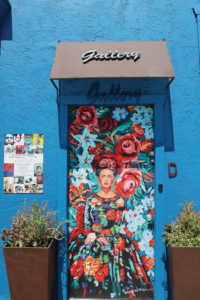

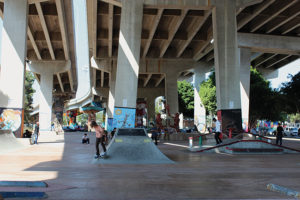
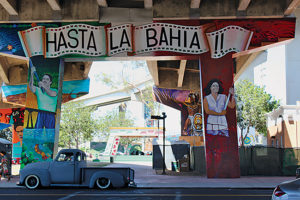
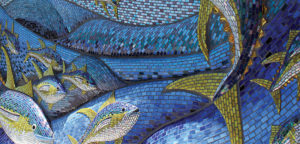
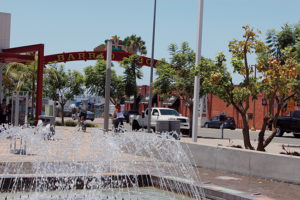
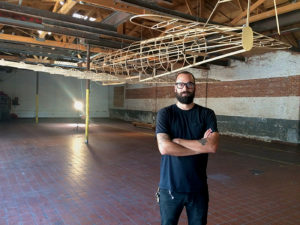
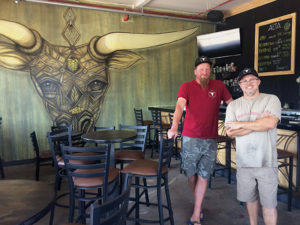
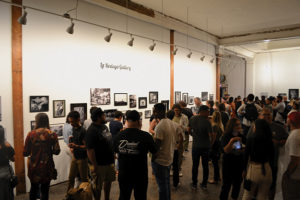
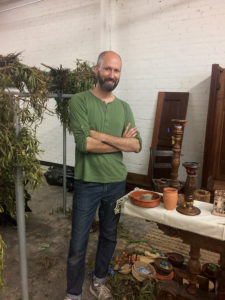
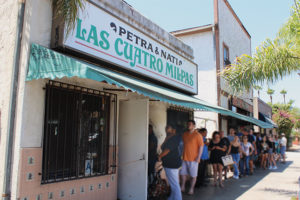

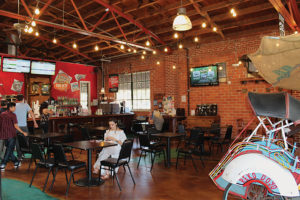
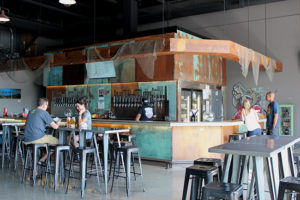
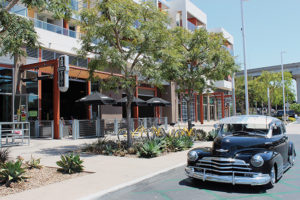
![]()

